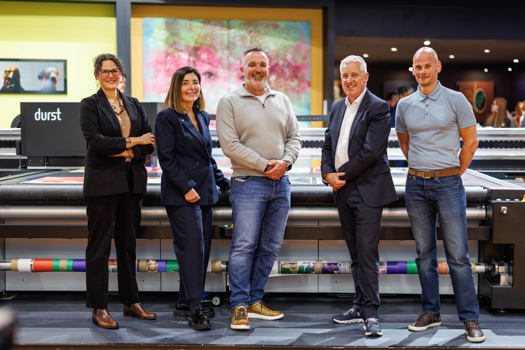The manufacturer confirmed this week that the Brenva HD Production Inkjet Press would be launched at Drupa.
It is its first product to combine technology from Xerox’s existing toner-based production printers with know-how from its Impika inkjet subsidiary.
“We refreshed all of our top-end cut-sheet portfolio in past 18 months and we are still very committed to that market space. Winning in cut-sheet is very important for us,” said Xerox president of global Graphic Communications Andrew Copley. “It’s also important to establish a strong position in markets with double-digit growth, such as inkjet and packaging. Capturing that new growth is very important to us as well.”
The B3-plus format Brenva has a maximum sheet size of 364x520mm and a print speed of 197 A4 images per minute, or half that in duplex mode. It uses Kyocera printheads.
The throughput in full-size sheets per hour is 3,960sph simplex, or 1,860sph duplex.
Features include an inline spectrophotomer, missing jet correction on-the-fly, front-to-back registration scanning, and vector halftoning. Users can also set up their own media profiles.
“There’s a lot of functionality in a box that is the size of the iGen that our customers know and love,” said Robert Stabler, senior vice-president of Xerox’s Graphic Communications Group.
“With the Brenva we are focused on business colour such as transactional print, books and manuals, and direct mail. For high coverage on coated media, iGen is the best option for the foreseeable future,” he added. “Between 10% and 20% coverage is really the sweet spot for this technology, where customers will get strong breakthrough economics.”
Xerox has set an aggressive price point of $649,000 (£463,000) for the Brenva with first shipments slated for June.
Existing B2 inkjet presses on the market typically cost in excess of £1m.
“It’s the start of a platform journey for us, it combines tried and tested components,” Stabler added.
There was also a hint that larger-format versions of the Brenva could be in the pipeline. “Some of it’s about time to market, and some about a solution that fits with customer workflows and finishing solutions. At present the best solution is around B3, it makes it much easier for customers to fit it into their workflows,” Copley said.
Xerox also announced the Trivor 2400, a 20in (50.8cm) production inkjet web with a small footprint. It runs at 100m/min at 600x600dpi in four-colour mode, or 200m/min in mono mode. In highest quality colour mode of 1,200x600dpi it will run at between 50-60m/min.
Pricing and availability for the Trivor will be disclosed at Drupa, where the Trivor will also be running on the Xerox stand. It is expected to ship later this year.
There’s also a new digital frontend inkjet print server for the Trivor 2400 and Impika devices of the same format, powered by EFI’s Fiery technology.
The unusual naming convention for the new inkjet presses comes from the names of mountains in France and Pakistan.
Xerox’s Drupa theme is ‘let the work flow’. Hubert Soviche, Graphic Communications marketing and strategy general manager, said the sound of equipment running in a successful print factory had “an unmistakable beat”.
“That sound of work truly flowing is like music to our customers’ ears. At Drupa 2016 we are excited to share with the world new ways to reinvent the flow of work,” he said.
Further news is expected in the coming weeks regarding cloud versions of Xerox’s workflow and Xmpie multi-channel marketing software.
Copley said Xerox’s plans to split into two separate businesses were progressing: “We are going through that journey this year and our goal is to have two independent companies on 1 January 2017.
“Nothing changes in day-to-day operations, while we reinvent ourselves into a more agile, nimble, focused company. We are upfront and explain it to our customers, and they see same opportunity as we do,” he stated.










